Mexico Video Surveillance Market Size
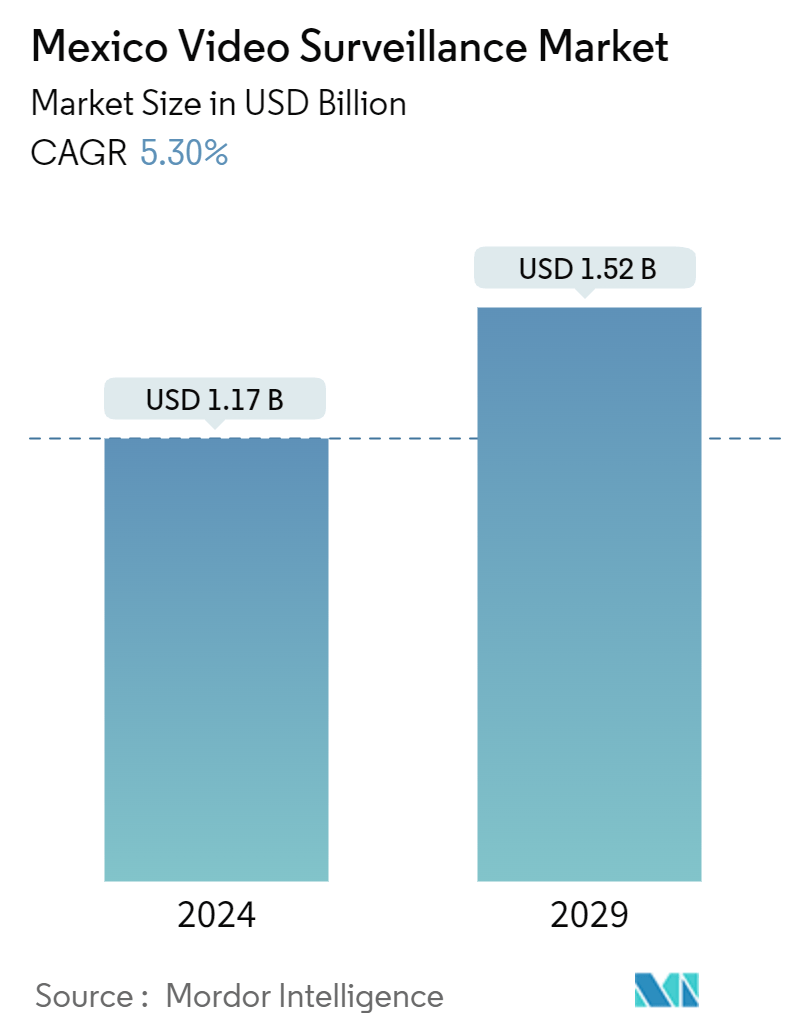
| Study Period | 2019 - 2029 |
| Base Year For Estimation | 2023 |
| Market Size (2024) | USD 1.17 Billion |
| Market Size (2029) | USD 1.52 Billion |
| CAGR (2024 - 2029) | 5.30 % |
| Market Concentration | Low |
Major Players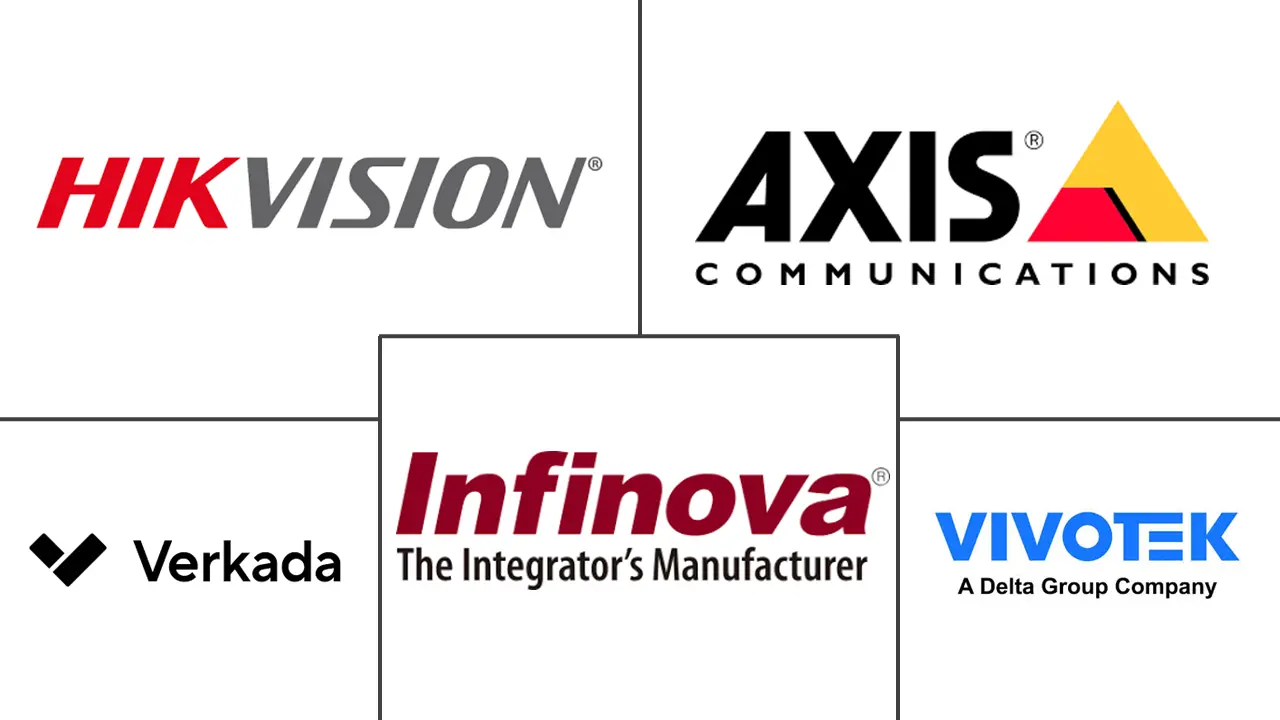
*Disclaimer: Major Players sorted in no particular order |
Mexico Video Surveillance Market Analysis
The Mexico Video Surveillance Market size is estimated at USD 1.17 billion in 2024, and is expected to reach USD 1.52 billion by 2029, growing at a CAGR of 5.30% during the forecast period (2024-2029).
- Mexico faces persistent issues with crime and violence, particularly in major urban centers, driving the demand for enhanced security measures. Protecting critical infrastructure, government facilities, and public spaces has become a top priority for public and private organizations. Video surveillance systems are an effective tool to deter crime, aid law enforcement, and improve public safety.
- Mexico is currently undertaking significant infrastructure projects, including the expansion of transportation networks, the development of smart cities, and the modernization of urban areas. These infrastructure developments present opportunities for integrating video surveillance systems to enhance security, traffic management, and urban planning. The government's focus on improving the country's infrastructure has led to increased funding and support for deploying video surveillance technologies.
- Rapid technological advancements have transformed Mexico's video surveillance sector. Cloud surveillance systems provide a user-friendly interface, allowing remote access via secure web portals or mobile apps. This feature is a game-changer for businesses with multiple sites and individuals who require remote property oversight. Such flexibility is vital for real-time monitoring and swift incident responses, a capability often restricted by the local network limitations of traditional VMS or NVR systems.
- The growing dependence on networked video surveillance systems has heightened worries regarding cybersecurity threats and data privacy. Video surveillance systems have become prime targets for hackers and cybercriminals seeking to breach security, disrupt operations, or steal sensitive data. Mitigating these risks necessitates stringent security protocols, including encryption, access controls, and frequent system updates. However, these measures, while crucial, can escalate the expenses and intricacies of deploying video surveillance systems.
- The fluctuations in Mexico's gross domestic product (GDP) directly influence the investment and spending behaviors of public and private entities. During times of economic upturn, organizations tend to boost their spending, especially on security infrastructure like video surveillance systems, benefiting from enhanced financial capabilities. Conversely, economic downturns or uncertainty often prompt budget cuts, leading to reduced investments in non-essential projects, potentially dampening the video surveillance market.
Mexico Video Surveillance Market Trends
Camera Hardware is Expected to Hold a Significant Market Share
- Surveillance camera demand in Mexico is bolstered by the escalating crime rates in the nation's capital. The National Public Security System highlights March 2023 as the peak month for reported crimes in Mexico City, hitting 22,125 cases. In stark contrast, December of the same year saw a significant drop, with reported crimes dipping below 17,000.
- The video surveillance market is witnessing a surge in camera technology, marked by the advent of high-resolution, low-light, and intelligent cameras. These advancements translate to crisper images, better object recognition, and more sophisticated analytics, rendering the cameras increasingly appealing and efficient for commercial users.
- IP-based cameras, with their enhanced connectivity, enable remote access, centralized management, and seamless integration with systems such as access control and building management. This connectivity, coupled with the ability to utilize existing IT infrastructure and tap into cloud services, positions IP cameras as a compelling choice for several end users in Mexico. The scalability of IP cameras is notable; they can be effortlessly added or relocated within a commercial setting, requiring minimal infrastructure adjustments.
- In retail stores, hotels, and office settings, dome cameras are favored for discreet indoor surveillance, boasting resistance to vandalism. Conversely, bullet cameras have extensive applications in outdoor security, particularly for monitoring perimeters, parking lots, and building entryways. PTZ cameras, known for their remote monitoring capabilities, empower operators to focus on specific zones and respond swiftly to incidents. Thermal cameras, on the rise, are pivotal for monitoring critical infrastructure, warehouses, and remote locations, excelling in detecting heat signatures and offering superior visibility in low-light scenarios.
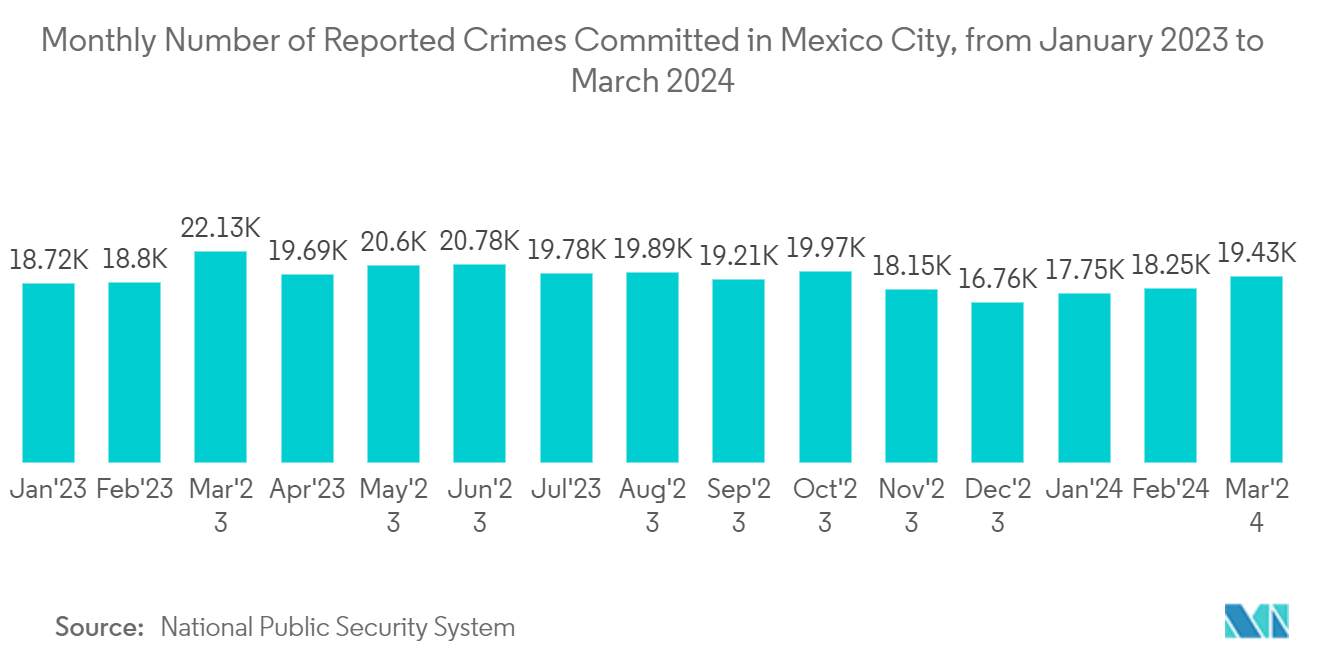
Commercial Segment is Expected to Witness Significant Growth
- The country's retail and hospitality sectors are experiencing rapid growth, propelled by a burgeoning middle class and a surge in tourism. Retailers, shopping centers, hotels, and restaurants widely adopt video surveillance systems to bolster security, combat theft, and streamline operations. With video surveillance, these establishments can closely track customer footfall, fine-tune staffing, and promptly address incidents.
- The need for video surveillance systems has intensified with the burgeoning commercial real estate landscape in Mexico, marked by a surge in new office spaces, shopping centers, and mixed-use complexes. In addition, as per Turner & Townsend, in 2023, resort-style hotels stood out as the commercial property type with the highest construction costs. Specifically, the average price per square meter of internal area was approximately USD 3,102. Such investment initiatives are expected to drive the studied market's growth.
- Video surveillance technologies have rapidly evolved, embracing the Internet of Things (IoT), cloud computing, and artificial intelligence (AI). This evolution has enhanced accessibility and made these solutions more affordable and user-friendly for commercial end users. The integration of high-resolution cameras, advanced analytics, and remote monitoring has significantly boosted the appeal and efficacy of video surveillance systems in commercial settings.
- Commercial end users are increasingly leveraging video surveillance systems for security and enhancing operational efficiency, elevating customer experiences, and bolstering business decision-making. Modern video surveillance solutions, with features like video analytics, people counting, and heat mapping, empower commercial establishments to glean crucial insights. These insights range from understanding customer behavior and traffic patterns to assessing operational performance. Commercial entities can fine-tune their operations with this business intelligence, elevate customer service, and chart more informed strategic paths.
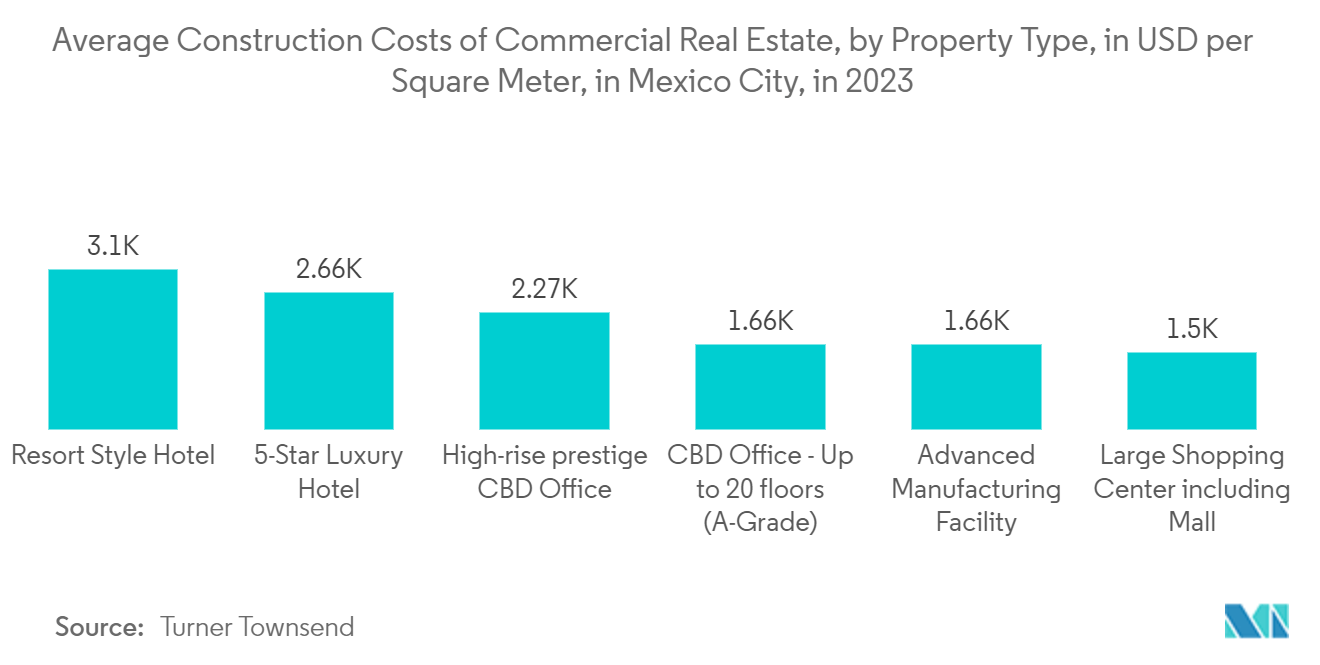
Mexico Video Surveillance Industry Overview
The Mexican video surveillance market is highly competitive, with several players. The players are strengthening their market position by acquiring several domestic contracts, innovations, partnerships, mergers, and acquisitions. Some of the key players in the market are Hangzhou Hikvision Digital Technology Co. Ltd, Dahua Technology Co. Ltd, The Infinova Group, Axis Communications AB, and Verkada Inc.
• May 2024: Verkada Inc. unveiled four new bullet cameras that have received validation under the Federal Information Processing Standard (FIPS). These FIPS-validated bullets are tailored for federal customers and partners, offering advanced features. These include License Plate Recognition, 4K resolution, 3x optical zoom, an impressive 50m IR range for enhanced night vision, and robust weather-resistant design. The models CB52-E-F, CB62-E-F, CB52-TE-F, and CB62-TE-F adhere to the FIPS 140-2 encryption standard endorsed by the National Institute of Standards and Technology. Notably, these FIPS Bullets also comply with the Trade Agreements Act (TAA) and the National Defense Authorization Act (NDAA).
• May 2024: In a strategic move, VIVOTEK bolstered its AI security portfolio by unveiling the 9383-Series network camera. This camera brings AI video analytics within affordable reach and excels in identifying key attributes of individuals and vehicles. The 9383-Series seamlessly pairs with either the Core+ AI Network Video Recorder (Core+ AI NVR) or the VAST Security Station (VSS) system. The Case Vault feature empowers the system to swiftly compile necessary video data, generating a comprehensive report in just a minute. This leapfrogs the previous hurdle of laborious data organization, underlining VIVOTEK's commitment to a holistic AI-driven security ecosystem.
Mexico Video Surveillance Market Leaders
-
Hangzhou Hikvision Digital Technology Co., Ltd.
-
The Infinova Group
-
Axis Communications AB
-
Verkada Inc.
-
Vivotek Inc. (A Delta Group Company)
*Disclaimer: Major Players sorted in no particular order
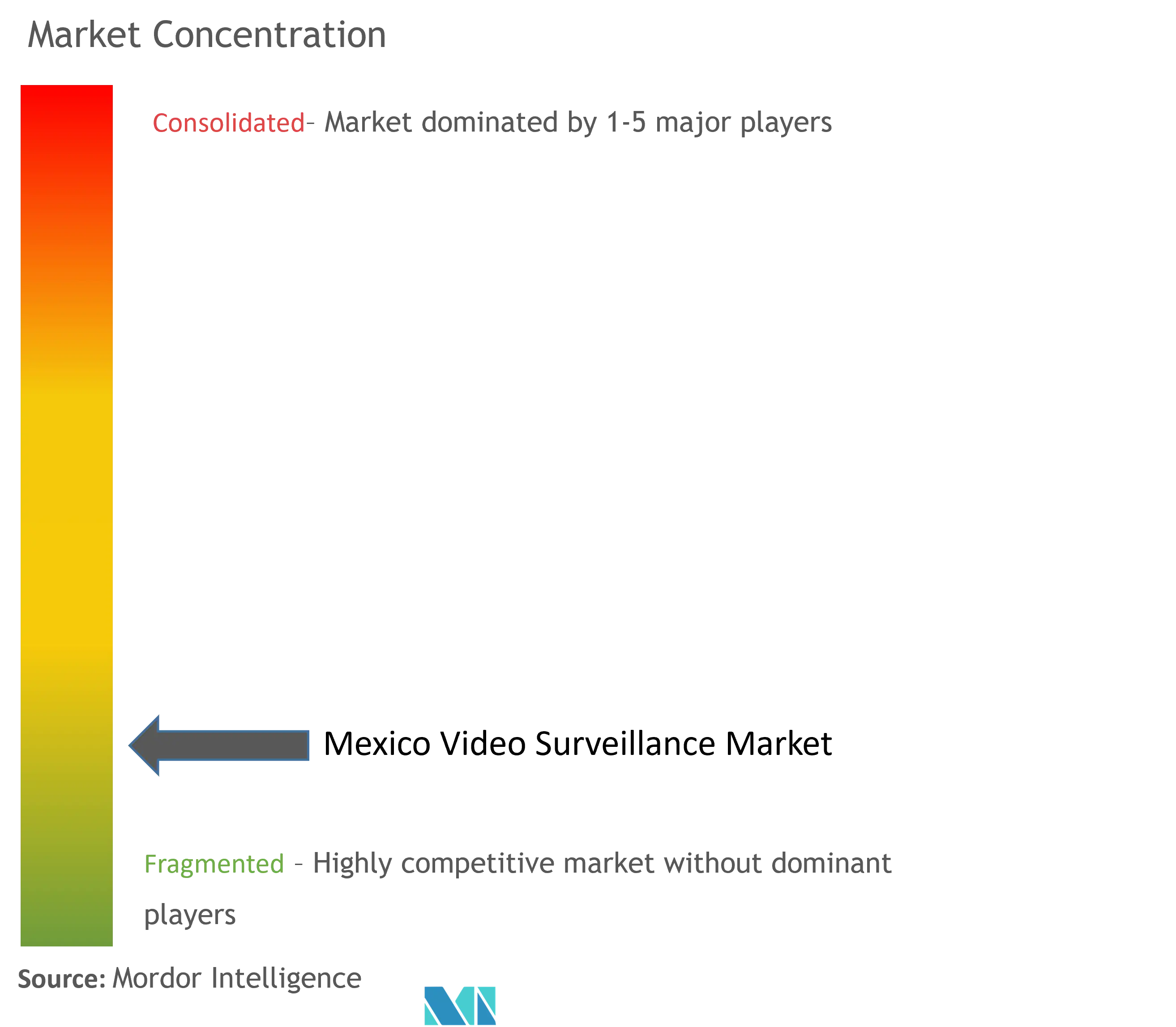
Mexico Video Surveillance Market News
- June 2024: Toluca City bolstered its security infrastructure by deploying an additional 200 cameras across strategic locations. This move enhances emergency response capabilities and fortifies crime prevention measures. Out of these, 50 cameras are designated for panic button monitoring, while another 50 are tailored for license plates and facial recognition. These cameras boast a 360-degree rotation and an impressive 150-meter clear range. The expanded surveillance blankets over 70% of the population, stretching from Toluca's industrial hub to the borders of Zinacantepec. Officials highlighted that with the latest additions, the city now boasts a network of 296 urban surveillance cameras, consolidating into 80 intelligent monitoring hubs.
- February 2024: The Port of Tampico Madero, situated on the east coast, underwent a significant modernization. This transformation included the installation of a surveillance system comprising 40 cameras and the establishment of a monitoring center. The project entailed setting up an infrastructure that provided a LAN network for camera services. This was achieved through SFTP Cat 6 structured cabling, supporting 40 cameras. These cameras were a mix of anti-explosion, anti-corrosion bullet types, and Hikvision PTZ cameras. They effectively monitor the critical infrastructure around the clock, even in saline and anti-explosion environments.
Mexico Video Surveillance Market Report - Table of Contents
1. INTRODUCTION
- 1.1 Study Assumptions and Market Definition
- 1.2 Scope of the Study
2. RESEARCH METHODOLOGY
3. EXECUTIVE SUMMARY
4. MARKET INSIGHTS
- 4.1 Market Overview
-
4.2 Industry Attractiveness - Porter's Five Forces Analysis
- 4.2.1 Threat of New Entrants
- 4.2.2 Bargaining Power of Buyers
- 4.2.3 Bargaining Power of Suppliers
- 4.2.4 Threat of Substitute Products
- 4.2.5 Intensity of Competitive Rivalry
- 4.3 Industry Value Chain Analysis
- 4.4 Impact of Macro Trends on the Market
5. MARKET DYNAMICS
-
5.1 Market Drivers
- 5.1.1 Growing Imperative for Heightened Safety and Security Measures
- 5.1.2 Evolution of Technology Such as Cloud-based Video Surveillance is Expected to Dominate
-
5.2 Market Restraint
- 5.2.1 Escalating Concerns over Privacy and Human Rights Violations
6. MARKET SEGMENTATION
-
6.1 By Type
- 6.1.1 Hardware
- 6.1.1.1 Camera
- 6.1.1.1.1 Analog
- 6.1.1.1.2 IP Camera
- 6.1.1.2 Storage
- 6.1.2 Software
- 6.1.2.1 Video Analytics
- 6.1.2.2 Video Management Software
- 6.1.3 Services (VSaaS)
-
6.2 By End-user Vertical
- 6.2.1 Commercial
- 6.2.2 Infrastructure
- 6.2.3 Institutional
- 6.2.4 Industrial
- 6.2.5 Defense
- 6.2.6 Residential
7. COMPETITIVE LANDSCAPE
-
7.1 Company Profiles
- 7.1.1 Hangzhou Hikvision Digital Technology Co. Ltd
- 7.1.2 Dahua Technology Co. Ltd
- 7.1.3 The Infinova Group
- 7.1.4 Axis Communications AB
- 7.1.5 Verkada Inc.
- 7.1.6 Eagle Eye Networks
- 7.1.7 Vivotek Inc.
- 7.1.8 Honeywell Security
- 7.1.9 Uniview Technologies Co. Ltd
- 7.1.10 IDIS Inc.
- *List Not Exhaustive
8. INVESTMENT ANALYSIS
9. FUTURE OF THE MARKET
** Subject To AvailablityMexico Video Surveillance Industry Segmentation
Video surveillance entails employing security cameras to oversee and document activities in a designated area, primarily for security, safety, or monitoring purposes. These cameras capture real-time footage, which can be either viewed instantly or stored for later scrutiny. This technology finds extensive application in public settings like streets, parking lots, airports, and shopping centers, as well as in private residences and commercial structures. The market size is estimated by selling video surveillance hardware and software products in several end-user verticals. The study also tracks the major vendors in the market with underlying growth trends in several industries. In addition, it also tracks the macroeconomic factors impacting the market.
The Mexican video surveillance market is segmented by type (hardware [camera [analog and IP camera] and storage], software [video analytics and video management software], services [VSaaS]), and end-user vertical (commercial, infrastructure, institutional, industrial, defense, and residential). The market sizes and forecasts are provided in terms of value in USD for all the above segments.
| By Type | Hardware | Camera | Analog |
| IP Camera | |||
| By Type | Hardware | Storage | |
| By Type | Software | Video Analytics | |
| Video Management Software | |||
| By Type | Services (VSaaS) | ||
| By End-user Vertical | Commercial | ||
| Infrastructure | |||
| Institutional | |||
| Industrial | |||
| Defense | |||
| Residential |
Mexico Video Surveillance Market Research FAQs
How big is the Mexico Video Surveillance Market?
The Mexico Video Surveillance Market size is expected to reach USD 1.17 billion in 2024 and grow at a CAGR of 5.30% to reach USD 1.52 billion by 2029.
What is the current Mexico Video Surveillance Market size?
In 2024, the Mexico Video Surveillance Market size is expected to reach USD 1.17 billion.
Who are the key players in Mexico Video Surveillance Market?
Hangzhou Hikvision Digital Technology Co., Ltd., The Infinova Group, Axis Communications AB, Verkada Inc. and Vivotek Inc. (A Delta Group Company) are the major companies operating in the Mexico Video Surveillance Market.
What years does this Mexico Video Surveillance Market cover, and what was the market size in 2023?
In 2023, the Mexico Video Surveillance Market size was estimated at USD 1.11 billion. The report covers the Mexico Video Surveillance Market historical market size for years: 2019, 2020, 2021, 2022 and 2023. The report also forecasts the Mexico Video Surveillance Market size for years: 2024, 2025, 2026, 2027, 2028 and 2029.
Mexico Video Surveillance Industry Report
Statistics for the 2024 Mexico Video Surveillance market share, size and revenue growth rate, created by Mordor Intelligence™ Industry Reports. Mexico Video Surveillance analysis includes a market forecast outlook for 2024 to 2029 and historical overview. Get a sample of this industry analysis as a free report PDF download.



